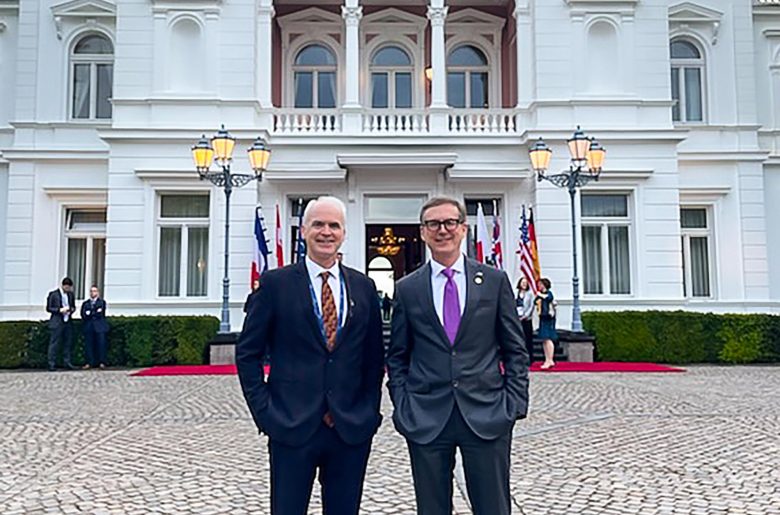
Global engagement
The Bank of Canada and its international counterparts faced an extremely challenging global environment in 2022. When COVID‑19 restrictions were lifted in many countries, demand rebounded sharply while major supply disruptions persisted, contributing to high inflation worldwide.
At the same time, Russia’s war against Ukraine intensified inflationary pressures, increased the uncertainty around the transition to net-zero emissions and disrupted the spirit of multilateralism.
The Bank focused its international efforts on:
- global forces affecting inflation and inflation expectations, and the value of a unified resolve to reduce inflation
- overlapping risks from the war in Ukraine, including working with other G7 central banks to monitor the impact of international financial sanctions
- the resilience of the international monetary and financial system
- concerns about financial stability
- climate risks
Throughout 2022, the Bank made its voice heard in global policy discussions, moving debates forward in several areas that matter for Canada. The Bank also showed leadership and promoted innovative thinking in working groups.
The Bank met regularly with central banks and financial market participants to build relationships, hear diverse opinions and improve its understanding of global policy issues.
Fighting inflation and monitoring spillovers
Tackling high inflation was a top priority for the Bank in 2022. The Bank worked with other central banks in the G7 and G20 to:
- monitor the impact of price pressures on inflation expectations
- communicate central banks’ shared commitment to price stability to limit the risk that high inflation becomes entrenched1
- monitor for unintended consequences and international spillover effects of widespread tightening of monetary policy
The Bank added value to the global dialogue on these issues by:
- conducting original research on the best policy strategies for keeping expectations anchored in the face of large supply shocks2
- explaining the roles that international spillover effects and inflation expectations have played in inflation dynamics since the pandemic started3
Evolving the international monetary and financial system
The Bank continued to press for changes to the international monetary and financial system so that it can withstand the challenges it faces. These challenges include:
- high volatility in emerging-market capital flows amid widespread tightening of monetary policy in advanced economies
- the need for a significant shift in capital around the globe to help countries transition to net-zero emissions, particularly those whose economies are highly exposed to the energy sector
- the digitalization of money and finance, which may make capital flows more volatile and allow shocks to spread quickly
As part of this effort, the Bank advocated for clear guidance from the International Monetary Fund (IMF) on the use of tools for managing short-run volatility while ensuring these policies do not impede long-run progress. Governor Macklem made a similar call to action in 2021.4 The IMF is responding through ongoing work to operationalize its Integrated Policy Framework.
Promoting resilience of the global financial system
The resilience of the global financial system remained a key area for collaboration in 2022. The most pressing topics of concern included:
- the banking system
- digital assets and payments
Strengthening the international banking system
The Bank co-chaired the Task Force on Evaluations, which operates under the umbrella of the Basel Committee on Banking Supervision (BCBS). This task force analyzes the effectiveness of Basel III reforms put in place after the 2008–09 global financial crisis. The Bank contributed to two key task force reports in 2022:
- an in-depth analysis of the usability and cyclicality of capital buffers within the Basel framework5
- the final evaluation of the Basel III reforms6
In addition, Governor Macklem was appointed Chair of the Group of Governors and Heads of Supervision, the oversight body of the BCBS.7 In this role, he provided strategic direction to the BCBS to fulfil its goal of strengthening the regulation, supervision and practices of banks globally.
Addressing the international challenges posed by digital assets and payments
The Bank continued working with international partners to promote coherent policies for regulating digital assets and payments. This included ongoing efforts to make cross-border payments cheaper, faster, more inclusive and more transparent than they are currently. In 2022, the Bank contributed to:
- a framework for linking national payment systems and outlining best practices for access to large-value payment systems8
- a study of how central bank digital currencies can be best designed to facilitate cross-border payments9
The growth of cryptoassets backed by national currencies, known as stablecoins, also spurred significant discussion. On this front, the Bank chaired the Financial Stability Board (FSB) working group that makes recommendations on the regulation and supervision of stablecoins. The Bank helped the working group assess the progress made against recommendations drafted in 2020.10
The Bank also collaborated on drafting guidance for applying the Principles for Financial Market Infrastructures to global stablecoins, based on a consultative process that took place in 2021.11
Finally, the Bank was an active participant in multiple FSB working groups focused on cryptoassets. Among other contributions, the Bank played an important role in the publication of a report on the regulation, supervision and oversight of cryptoassets and markets.12
Collaborating with partners on diversity and inclusion
In the autumn, the Bank hosted the Conference on Diversity, Equity and Inclusion in Economics, Finance and Central Banking. It organized the event with the Bank of England, the European Central Bank and the US Federal Reserve.
Participants explored some of the challenges that women and under-represented groups face. The conference featured more than 30 speakers and was webcast so that the public could be part of the discussions.
Looking forward
In 2023, the Bank will:
- work with its international counterparts to assess the current and future risks to global growth and the evolution of global factors driving inflation
- bring together scholars and experts to debate the future of the international monetary and financial system at the Bank’s 2023 Annual Conference
- strengthen partnerships and find opportunities to lead the conversation on major policy challenges facing the Canadian and global economies, such as climate change and the transition to net-zero emissions
- continue to integrate its research into global policy work
- support the implementation of the FSB roadmap for cross-border payments
- lead international efforts to strengthen prudential regulation of banks and push for coherent international policy frameworks for digital assets and payments
- continue to chair the Group of Governors and Heads of Supervision and the G7 Central Bank Digitalization Working Group
More information
G7 Finance Ministers and Central Bank Governors’ Petersberg Communiqué
- 1. For example, see G20 Research Group, “G20 Chair’s Summary” (Fourth G20 Finance Ministers and Central Bank Governors Meeting, Washington, DC, October 13, 2022).[←]
- 2. See P. Beaudry, T. J. Carter and A. Lahiri, “Looking Through Supply Shocks versus Controlling Inflation Expectations: Understanding the Central Bank Dilemma,” Bank of Canada Staff Working Paper No. 2022-41 (September 2022).[←]
- 3. See P. Beaudry, “Anatomy of a pandemic: Applying old lessons and learning from new ones” (speech delivered to the University of Waterloo Faculty of Arts, Waterloo, Ontario, September 20, 2022).[←]
- 4. See T. Macklem, “The long and short of it: A balanced vision for the international monetary and financial system” (remarks delivered virtually to the Council on Foreign Relations, Washington, DC, October 7, 2021).[←]
- 5. Bank for International Settlements, “Buffer usability and cyclicality in the Basel framework,” Basel Committee on Banking Supervision second evaluation report (October 5, 2022).[←]
- 6. Bank for International Settlements, “Evaluation of the impact and efficacy of the Basel III reforms,” Basel Committee on Banking Supervision third evaluation report (December 14, 2022).[←]
- 7. Bank for International Settlements, “Tiff Macklem appointed Chair of the Group of Governors and Heads of Supervision, oversight body of the Basel Committee” (press release, April 1, 2022).[←]
- 8. For more information, see Bank for International Settlements, “Interlinking payment systems and the role of application programming interfaces: a framework for cross-border payments,” Committee on Payments and Market Infrastructures report to the G20 (July 2022), and Bank for International Settlements, “Improving access to payment systems for cross-border payments: best practices for self-assessments,” Committee on Payments and Market Infrastructures report (May 2022).[←]
- 9. Bank for International Settlements, “Options for access to and interoperability of CBDCs for cross-border payments,” Committee on Payments and Market Infrastructures, BIS Innovation Hub, International Monetary Fund and World Bank Group report to the G20 (July 2022).[←]
- 10. Financial Stability Board, “Review of the FSB High-level Recommendations of the Regulation, Supervision and Oversight of ‘Global Stablecoin’ Arrangements: Consultative report” (October 11, 2022).[←]
- 11. For more, see Bank for International Settlements and International Organization of Securities Commissions, “Application of the Principles for Financial Market Infrastructures to stablecoin arrangements,” Committee on Payments and Market Infrastructures and Board of the International Organization of Securities Commissions report (July 2022).[←]
- 12. Financial Stability Board, “Regulation, Supervision and Oversight of Crypto-Asset Activities and Markets: Consultative document” (October 11, 2022).[←]
